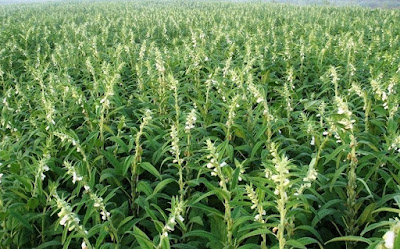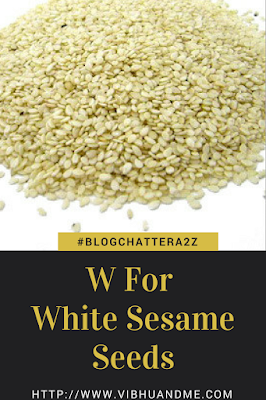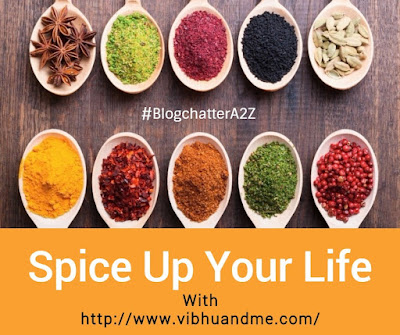Tell me one thing that you like most about winters? For some people, winter could be a time to enjoy the icy weather, for me the best thing about winter is Food. With winter comes great fruits and vegetables. Despite all that we eat, our stomach stays chill. During the winters, I also enjoy one more delicacy, that is, Gajak. The crispy, nutty, sweet and tasty gajak becomes my everyday snack in the winters. In Delhi, as winter approaches, gajaks, chikky, and other jaggery made items are easily available too as these are sold at a number of shops. The base ingredient in these winter savories is a tiny yet super healthy white seed known as 'Sesame'.
W For White Sesame Seeds
Sesame Seeds or Til (In Hindi) are an indispensable part of Indian winters since ancient time. From til ke ladoo to variety of til ki gajak, it is difficult to imagine winters in India, without taking sesame into account. Although the significant ingredient I am talking about starts with letter S, I did not mentioned it in the super ingredient list starting with letter S. This is because these Sesame seeds have four different variants that are distinguished in color; these are white, black, red and brown sesame seeds. As I am talking here about the sesame variant used in those winter special gajaks and chikkies, I need to name it as White Sesame in particular.
This white, tiny, oval-shaped nut is the oldest oil-seed crop ever known to the humans and considered as one of the healthiest food. Sesame seeds add a nutty taste and a delicate, nice crunch in our dishes. They are not only popular in India but also in other Asian countries. The famous Tahini paste is made from sesame seeds and every other Chinese dish also has white sesame seeds added to it. Sesame seeds come from a plant in the genus Sesamum. The seed pods burst open when they are fully grown and give us these lively seeds. Sesame seeds contain up to 55 percent oil and 20 percent protein, making it a high source of both essential fatty acids and certain amino acids.
According to one of the Hindu legends, sesame seeds signify 'immortality'. The seed oil is considered holy for liting the diyas during the puja. Lightening a lamp with sesame oil is assumed good for eliminating doshas of grahas (astrological planets) and repels evil spirits.
My mother swears by the benefits of sesame oil. She uses it for massaging her knees, for keeping her gums healthy and for making her skin glow. I also do fasting of Sankat Chuath which is dedicated to God Ganesha and in puja, offering all Til made things is assumed auspicious. When any food is part of customs and puja, this clear signify its glory and importance.
History of White Sesame Seed
Sesame is one of the oldest seeds known to mankind. There is a difference in opinion whether sesame originated in India or Africa. But those who believe its origin in India, they say from India, sesame seeds were introduced to the Middle East, Africa and Asia. The first written record of sesame is said be found from 3,000 BC. In the Assyrian mythology, there is an amusing myth about sesame seeds that says that the Gods had sesame seed wine a night before they created the earth.
The reference of the use of sesame oil is found in the era of Babylonians, and Egyptians grew their own sesame to make flour. Persia, the birthplace of the 1001 Arabian Nights, has long been savvy to sesame's benefits. Ancient Persians relied on it both as a food and for its medicinal qualities. The famous Tahini belongs to them only. Strangely the ancients first relied on the sesame plant to provide oil, and only later discovered its value as a food source. The exact mention when sesame reached China is unclear but the full hand use of sesame in Chinese cuisine holds the fact that it is there since ages. It was during the late 17th century when the Sesame seeds were brought to the United States from Africa. Currently, India, China and Mexico are the largest producers of sesame seeds in the world .
Ayurvedic Benefits of Sesame
W For White Sesame Seeds
Sesame Seeds or Til (In Hindi) are an indispensable part of Indian winters since ancient time. From til ke ladoo to variety of til ki gajak, it is difficult to imagine winters in India, without taking sesame into account. Although the significant ingredient I am talking about starts with letter S, I did not mentioned it in the super ingredient list starting with letter S. This is because these Sesame seeds have four different variants that are distinguished in color; these are white, black, red and brown sesame seeds. As I am talking here about the sesame variant used in those winter special gajaks and chikkies, I need to name it as White Sesame in particular.
This white, tiny, oval-shaped nut is the oldest oil-seed crop ever known to the humans and considered as one of the healthiest food. Sesame seeds add a nutty taste and a delicate, nice crunch in our dishes. They are not only popular in India but also in other Asian countries. The famous Tahini paste is made from sesame seeds and every other Chinese dish also has white sesame seeds added to it. Sesame seeds come from a plant in the genus Sesamum. The seed pods burst open when they are fully grown and give us these lively seeds. Sesame seeds contain up to 55 percent oil and 20 percent protein, making it a high source of both essential fatty acids and certain amino acids.
 |
| Sesame plants (Credit: Google Image search) |
My mother swears by the benefits of sesame oil. She uses it for massaging her knees, for keeping her gums healthy and for making her skin glow. I also do fasting of Sankat Chuath which is dedicated to God Ganesha and in puja, offering all Til made things is assumed auspicious. When any food is part of customs and puja, this clear signify its glory and importance.
History of White Sesame Seed
Sesame is one of the oldest seeds known to mankind. There is a difference in opinion whether sesame originated in India or Africa. But those who believe its origin in India, they say from India, sesame seeds were introduced to the Middle East, Africa and Asia. The first written record of sesame is said be found from 3,000 BC. In the Assyrian mythology, there is an amusing myth about sesame seeds that says that the Gods had sesame seed wine a night before they created the earth.
The reference of the use of sesame oil is found in the era of Babylonians, and Egyptians grew their own sesame to make flour. Persia, the birthplace of the 1001 Arabian Nights, has long been savvy to sesame's benefits. Ancient Persians relied on it both as a food and for its medicinal qualities. The famous Tahini belongs to them only. Strangely the ancients first relied on the sesame plant to provide oil, and only later discovered its value as a food source. The exact mention when sesame reached China is unclear but the full hand use of sesame in Chinese cuisine holds the fact that it is there since ages. It was during the late 17th century when the Sesame seeds were brought to the United States from Africa. Currently, India, China and Mexico are the largest producers of sesame seeds in the world .
Ayurvedic Benefits of Sesame
Prized in Ayurveda for its ability to generate heat and energy in the body, sesame seeds come with numerous beauty and hair benefits. They are loaded with nutrition that makes it a must-have in your winter diet. Sesame is used in various forms in Ayurvedic medicines; powder paste, oil, and whole as well. Ayurveda assumes black sesame seeds more beneficial than white ones. Mentioned as "Shukl Tila", white sesame is prescribed for many health issues. These seeds are an excellent source of copper, manganese, magnesium, calcium, phosphorus, iron, zinc, molybdenum, and selenium. Some more health and beauty benefits of sesame seeds :
- Antioxidant
- Anti-aging
- Boosts Skin Health
- Boosts Dental and bone health
- Good Source of Energy
- Boosts Digestion
- Stabilizes blood pressure
- Helps Fight Stress and Depression
- High Source of Unsaturated Fats
- Good Hair Growth
- Balances hormones
Dadi Maa Ka Nuskha
Chew a spoonful of white sesame seeds every day. It is a great and easy way to get calcium.
How to buy
Both white and black sesame seeds are available easily in the market. The super benefiting oil is also up for grab. I would highly recommend sesame oil for daily skin routine. Add roasted sesame seeds in your curries and salads. They are the most inexpensive superfoods.
Chew a spoonful of white sesame seeds every day. It is a great and easy way to get calcium.
How to buy
Both white and black sesame seeds are available easily in the market. The super benefiting oil is also up for grab. I would highly recommend sesame oil for daily skin routine. Add roasted sesame seeds in your curries and salads. They are the most inexpensive superfoods.
(I am taking part in #BlogchatterA2Z and today’s letter is 'W'.)
You can read my other #BlogchatterA2Z posts here :
You can read my other #BlogchatterA2Z posts here :
- A For Alkanet Root - A Magical Spice
- B For Black Salt - A Digestive Stimulant
- C For Cinnamon - God of Spices
- D for Dried Ginger - A More Beneficial Form of Ginger
- E For Edible Silver and Gold Foils
- F For Fennel Seeds - More Than A Mouth Freshener
- G for Green Cardamom - The Queen of Spices
- H For Holy Basil - The King of Herb
- I For Indian Gooseberry - A Super food
- J For Jaggery - A Medicinal Sugar
- K For Kalpasi - An Unknown Treasure
- L For Long Pepper - An Underrated Spice
- M For Mace - The Cousin of Nutmeg
- N For Nutmeg - The Pricey Spice
- O For Onion Seeds - The Flavor Master
- P For Poppy Seeds - The Nutty Savor
- Q For Quinoa And Quatre-Epices
- R For Red Chili - The Fierce Spice
- S For Star Anise - The Beautiful Spice
- T For Turmeric - The Golden Spice
- U For Urad Dal - A Great Tempering Ingredient
- V For Vinegar - The Sour Agent












Comments
Post a Comment